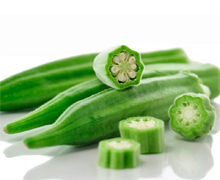
- Address : P.O. Box 11, Gannoruwa rd, Peradeniya, Sri Lanka
- E- Mail : director.hordi@doa.gov.lk
- Telephone :(+94) 081-2388011-12-13
- Fax :(+94) 081-2388234

Okra
Abelmoschus esculantus
A crop belonging to family Malvaceae. Easy to grow and can be grown in throughout the year, making it popular among farmers.
At present it is cultivated successfully in Hambanthota, Kurunegala, Rathnapura and Mathale districts and spreading into Anuradhapura, puttalam. Mathara, Badulla and Moneragala districts. Consumes young pods, but leaves are a delicacy in India and Africa. Nutrient level is very high, fibres, minerals, especially calcium and Iodine are presence in immature pods. Okra plays an important role in controlling thyroxine related disease since calcium and iodine availability is high.
Released Varieties
Climatic requirements/ Areas suitable for cultivation
Can be cultivated in any agroclimatic zone, except in up country wet zone. Yala – early April to Early May. Maha – Early September to Early October.
Soil
A well-drained Soil that is neither acidic or alkaline is suitable for successful growth of the plant
Seed requirement
4.5 kg/ha
Land preparation
Harrow the soil and break soil finely. Mark pits according to given spacing; fill the pits with decomposed organic matter. Make several drains to avoid water retention / logging
Field establishment
Direct seeding is practiced.
Soak seeds in water for about 24 hours before sawing. Plant about 3-4 seeds per pit. Keep the field with sufficient moisture.
After 2 weeks of seedling emergence, leave 2 healthy plants per pit and remove the excess
Spacing
Between rows 90 cm
Between plants – within the row: 60 cm
Fertilizer
Mix 10 t/ha of well decomposed organic matter with soil. Additionally apply chemical fertilizers as recommended. Apply basal fertilizers 2-3 days before planting
Times for apply | Urea kg/ha | TSP kg/ha | MOP kg/ha |
Basal fertilizer | 50 | 195 | 25 |
Top dressing (2 weeks after planting) | 50 | – | 25 |
Top dressing (5 weeks after planting) | 100 | – | 50 |
Top dressing (8 weeks after planting) | 100 | – | 50 |
Water supply/ Irrigation
Irrigate twice a day until seeds are germinated. After that irrigation should be practiced according to moisture condition in the soil
Weed Control
When plants are young, remove weeds by hand around the plants. Always keep the cultivation free of weeds. It will reduce the risk of pests and diseases.
Pest Management
Disease Management
podosphaera Spp Symptom
Disease control
|
Okra mosaic virus (Begomovirus) Symptom
Disease control
|
Harvesting and Processing
Can be harvested every 2 days up to 25 times over 50-100 days after planting
Harvest in morning, with the stalk so as not to damage the harvest.
Sort and remove diseased, deformed , mature and pest affected pods
Avoid direct sunlight on harvested pods
Pack in baskets to ensure good ventilation and not damage the harvest
Yield
Varies with the season, variety and climate. Average yield is about 10-15 metric tons per hectare.OKH1 (Hybrid)gives an average yield of 30 t/ha
